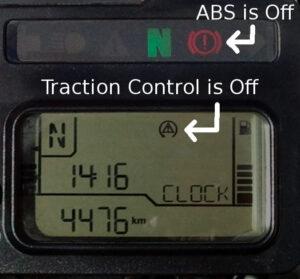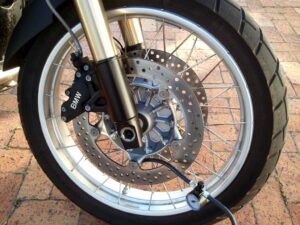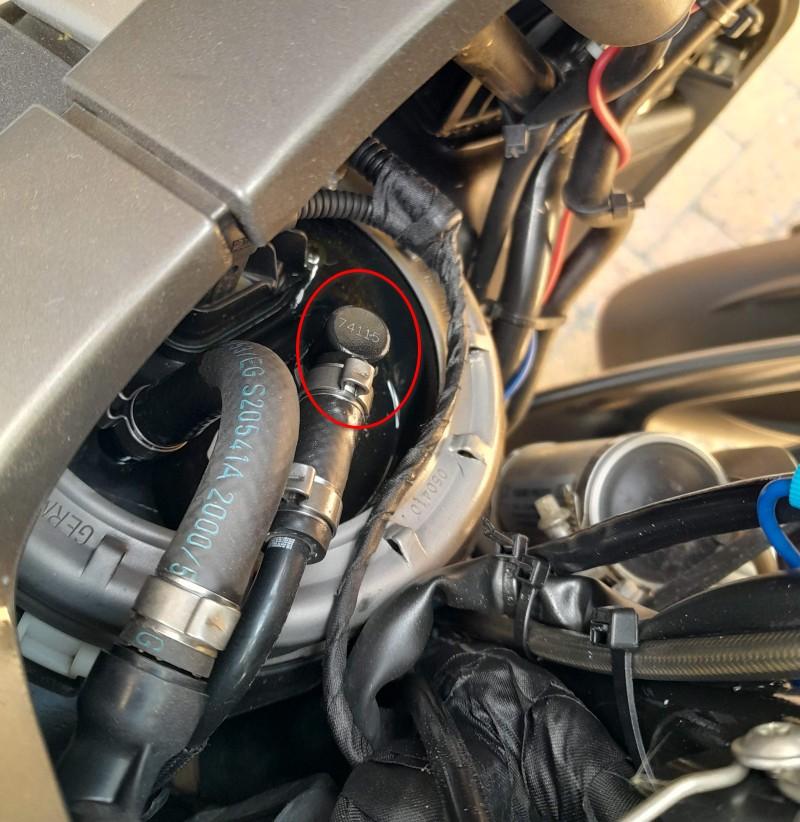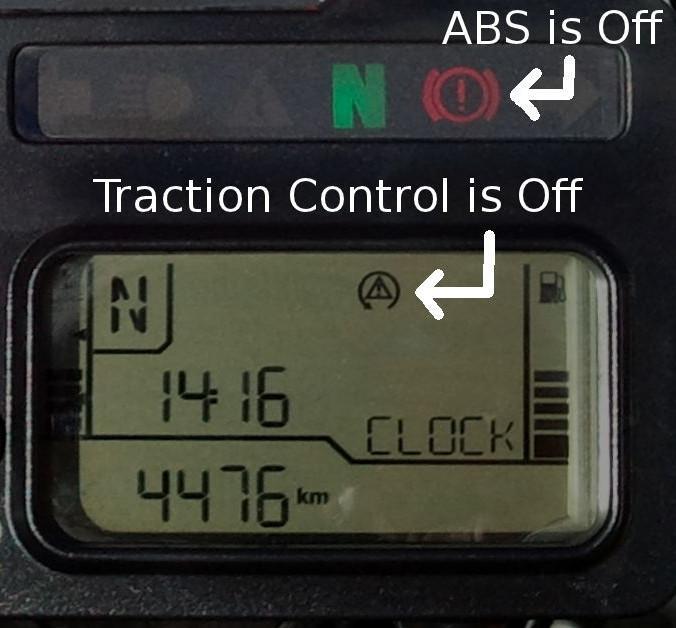Some useful tips I have picked up from others on operating the BMW R1200GS motorcycle
Disabling ABS and Traction Control for Off-Road
One thing I struggled to master was switching off the ABS and the traction control on the R1200GS. I had already see what an improvement the disabling of ABS makes when braking hard on gravel. Now that I was fully familiar with the bike I made another turn by Rynier at Hamman Motorrad in July 2011 to get the lowdown on this (Hamman Motorrad has closed and Rynier is now working at Vespa South Africa). This time it all made sense very quickly. So here is what he told me:
You can switch the traction control on and off while moving, but for the ABS you need to be standing stationary with the engine idling. Both can be switched on and off independent of each other so there is no need to do the one and then the other.
To set the ABS you should only watch the warning lights display on the instrument cluster and ignore anything that changes on the multifunction screen below. The key things to remember with ABS is that you want to get the ABS light to burn steadily indicating that ABS is disabled (it is the red light with the exclamation mark in the middle surrounded by a circle and what looks like brake shoes on the left and right outer edges of the circle). A long press on the ASC/ABS button will deactivate the ABS and set the ABS light to burn a steady red. Another long press of the ASC/ABS button will turn the warning light off and reactivate the ABS. (Note: When you first switch on the ignition and have not started to move forward, the ABS light will be flashing, which means it is active and normally after you start moving the warning light will go out.) So if you have been riding, and you have just stopped after leaving a tar road and want to deactivate the ABS for off-road use, there will be no ABS warning light flashing when you start the procedure above.
Note with the newer models that have Enduro Pro mode: This turns off the ABS on the rear wheel, but keeps it active on the front wheel. The older models, as described above, did not have this option as ABS was on/off for both wheels.

To set the traction control you will use the same button, but the differences are you will use a medium length press, and you will be watching the multifunction screen only. The first press will show the off-road soft setting (with an S-symbol), press it again until you see the symbol come on with an exclamation mark inside the small triangle that has an arrow circling it. Now the traction control is completely disabled (the S-symbol should be off). Again the presence of this symbol is a warning that the traction control is deactivated.
Another medium press (even if moving) will extinguish the warning symbol and activate traction control again. Another way to reactivate both ABS and traction control, is to switch off the ignition and to restart the bike.
So in summary, it is key to distinguish between the types of button press (quick versus a medium press versus a much longer press) and also to only watch the correct display and not get distracted by any other symbols that flash or change.
Tyre Pressures
When starting the bike, the tyre (US = tire) pressure sensors only display tyre pressure after the bike has reached a speed of 30-40 km/h. One quick tip for checking tyre pressures is not to switch the bike’s ignition off. Use the kill switch to stop the engine but leave the ignition on. The tyre pressures will continue to display while you pump up, or release air, from the tyres. Note: It is easy to damage the valve when the garage’s pump nozzle is forced onto the valve for bikes that have tyre pressure monitors. These valve stems can easily break off and will cost as much as R 1,300 ($77) each to replace. ALWAYS pump your own tyres and maybe another idea is to carry a small L-adaptor in your jacket pocket that will allow the pump nozzle to fit easier. You also have to be careful with these adaptors that you support it from the opposite side so as not to put too much sideways pressure on the valve. A further tip I got from Rynier is that if you stop with the front tyre’s valve at the bottom (see photo below) you can safely insert a garage’s pump through the front wheel’s disc brake, and it should align correctly with the front tyre valve.

More good practical advice from Wild@Heart in Cape Town, who specialise in adventure rides into Africa (so they know what they are talking about):
When riding on gravel, sand or rocky terrain. Deflating your tyres give you a bigger footprint and contact area with the road (more rubber on the road) and therefore help with stability and traction. Normal road pressure is 2.8 Bar in the front and 3.0 Bar at the rear when running off-road tyres. The tyres run cooler and have less wear. A general rule of thumb is to deflate to 1.6 Bar front and rear when you leave the tar for a dirt or gravel road. When you get to mud or sand, deflate further to 1 Bar. On Tubeless tyres, you can deflate to a further 0.7 Bar for really-really hectic deep sand tracks. But….. the terrain might change …. be very aware of rocks and potholes and inflate a few points to 1.0 Bar when needed. On Tube Type tyres, do not deflate the tyres under 1.0 Bar when encountering sand tracks. You are running the risk of shearing the valve off the tube under severe acceleration. What happens is that when the tyre is deflated under 1.0 Bar, the tyre itself loses grip over the rim. Under heavy acceleration, the rim starts turning faster than the tyre itself, which can result in a valve on the tube being ripped off. In all circumstances it is important that you also take the weight of the rider, luggage and if you ride with a pillion into consideration. Each individual case is different, and you will have to experiment a bit to find what works best for you.
Lifespan of a tyre: If you drive a typical number of kilometres annually with your motorcycle, a tyre’s tread will wear out, long before the rubber compound does. In general, the average lifespan of a tyre is six years from their production/manufacture date, regardless of the tread left. Tyre manufacturers, such as Continental and Michelin, say a tyre can last up to 10 years, provided you get annual tire inspections after the fifth year.
Off-Road Riding
Generally, you will want to:
- Deflate the tyres to gain extra traction. With tubeless tyres, you can easily go down to half the normal pressure. You can actually ride on next to no pressure, but the risk is that the wheel rim could slip in the tyre when it is under stress, or hitting a rut hard could damage the wheel rim. When reaching a tar road, and you do not have a pump, it is quite safe to ride up to 60km/h until you can reach a garage to pump up the tyres. Remember though that an underinflated tyre will run hotter, so keep the speed down if you are riding short stretches of tar with under-inflated tyres. As a rule of thumb, you can go down to 1,6 bar for normal dirt, and as low as 0,8 bar for sand.
- Deactivate ABS – this actually halves the braking distance on a gravel road as the ABS reduces the braking effectiveness on gravel. This setting can only be adjusted when standing stationary and resets when the engine is switched off and on again. Newer models can use Enduro Pro mode.
- Deactivate traction control – allows you to spin the rear wheel for cornering etc. Or try the “S” setting for an off-road setting for traction control. It can be changed whilst in motion, and also resets itself to being on after the engine is switched off and on again.
- If you have electronically adjustable suspension, set it for one of the two off-road settings. This adjusts the suspension dampers (shock absorbers) to soak up the minor bumps. This in combination with reducing tyre pressure means a fairly good gravel road will ride like it is a smooth tar road. This setting can only be adjusted when standing stationary but will retain its setting after the engine is switched off and on again.
- Stand up on the foot pegs – apart from seeing better, your legs will absorb the shock and movement of the bike without throwing you off balance.
- Emergency stopping – always immediately lock the rear wheel to act like an anchor, and then gradually increase the pressure on the front brakes.
- You should be leaning forward when going up an incline (i.e. body stays vertical) and leaning backwards when going down a decent (to put weight on the rear wheel for traction).
- It is strongly recommended that you attend at least a basic off-road course, as you will learn the finer details and also be able to safely practice the techniques until they become a habit. These courses are not at all expensive and are usually one-day courses.
Lifting the bike after a Fall
This can (and does) happen when riding and the key thing to remember, is to not lean forward / face towards the bike to try to pick it up. Rather, sit on the bike, with your back towards the bike. Then grip the handlebars (turning them inwards often helps) and the passenger hand-grip (or whatever you can hold tight), and use your legs to lift the bike upwards. Don’t lift too quickly, or you may have it falling over on the opposite side!
Mounting a heavy bike
This is a good tip if you find it difficult to straighten a bike which is leaning quite heaving on the side stand. Try turning the steering wheel away from the side that it is leaning on. Watch this video:
Oil Usage
The bike uses on average 1 L per 10,000 km (this is normal) and I discovered at 7,000 km that my oil warning came on (6,000 km travelled since 1,000 km service) and I had to put in 500 ml of oil. Oil level should be checked with the bike on its centre stand with the engine warm. The oil level should be visible in the sight glass. So the best advice is to always check the oil level before any long trip and definitely every 2,000 km or so.
Fuel Flange Issue
Seems there has been a known issue about this plastic fuel flange (a quick disconnector) that sits on top of the fuel pump. Mine just failed after 10 years of use (and about 26,000 km). What I’d noticed is, when I turned the ignition on, fuel sprays up vertically from the left top side of the tank. Seems it is made of plastic that fractures. Some have it replaced with a metal part.

Service Manuals
Lots of manuals available from this site.

